Other Good Ideas
Climbing toward Everest (on your micro!)
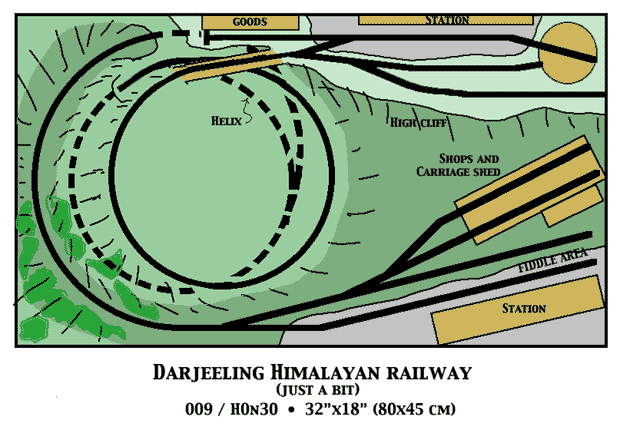
I couldn’t resist. One of the world’s best-loved narrow gauge railways is the Darjeeling Himalayan Railway in northeast India, near Nepal. This little two-foot gauge line climbs 7,000 feet from Siliguri at sea level to Darjeeling, within sight of Mt Everest. It’s one of the most irresistible prototypes in existence. Click here to visit the DHR website.
The challenge, of course, was to work an operating bit of the DHR into a micro-sized layout, in four square feet. It’s obviously an impossible task, so here it is. The behind-the-scenes trick that makes it work is a hidden helix with a six-inch radius — a steep and tough climb, but feasible for light OO9/HOn30 rolling stock.
The line starts at the lower terminus, where the tall passenger station blocks the viewer’s line of sight and allows us to fiddle train consists from the side, hidden from the front view. If you can manage an extension to the right, an early priority would be to add a proper fiddle yard, and save wear and tear on your fingers and tweezers! The line departs the terminal, with a train of ramshackle coaches pulled by a blue Class B 0-4-0 chuffing mightily along. The train soon disappears in the tropical rain forest, where in years past passengers could lean from the coaches and pick orchids from the trackside trees.
 Once out of sight, the train enters a hidden tunnel (that shouldn’t be there on the tunnel-less DHR) and climbs a steeply inclined helix inside the mountain. The number of turns depends on how high you want to make the upper terminus, but notice that the final turn is offset to the right and is out in the open, representing one of the spectacular 50-foot-radius loops that the DHR uses to gain altitude fast. One helix turn plus the exposed loop should get you to about a 6″ elevation (15 cm).
Once out of sight, the train enters a hidden tunnel (that shouldn’t be there on the tunnel-less DHR) and climbs a steeply inclined helix inside the mountain. The number of turns depends on how high you want to make the upper terminus, but notice that the final turn is offset to the right and is out in the open, representing one of the spectacular 50-foot-radius loops that the DHR uses to gain altitude fast. One helix turn plus the exposed loop should get you to about a 6″ elevation (15 cm).
The upper terminus is completely visible, with a turntable completing the runaround loop. The train is reversed, and eventually heads back down the mountain. There’s some freight switching to do as well, which will be challenging in the crowded little yard up there. And all this activity is performed in front of a majestic photographic background depicting the breathtaking Himalayan mountains.
You can name the stations anything you wish and move the line to Colorado or Switzerland, if that suits your modeling fancy. Or you can name them Siliguri and Darjeeling, if you’re feeling particularly expansive. A number of English firms make DHR carriages and locomotive kits, so populating an Indian version of the line should not be difficult.
Although it’s very small, this pint-sized Darjeeling Himalayan layout can offer some realistic operation, and can reproduce a small simulation of the struggle to climb the Himalayas that has made the DHR one of the world’s most popular railway lines.
A Tramway in the Channel Islands
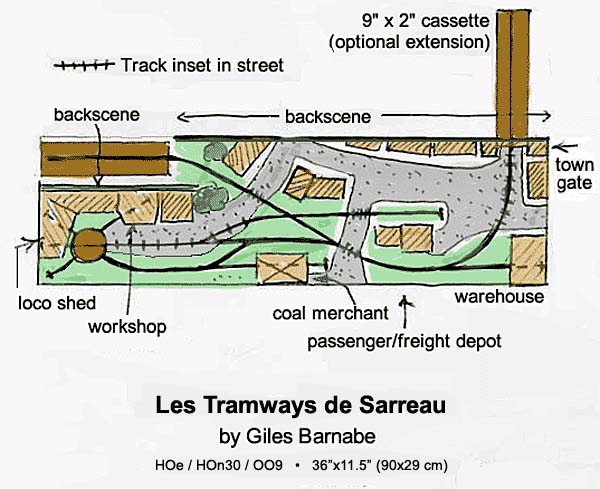
From the experienced hands of Giles Barnabe comes this traditional fiddle-yard-to-terminus layout with a twist… Les Tramways de Sarreau is a narrow-gauge line in the Channel Islands! It’s based on the 60 cm lines once common in France. This one is set on the imaginary Channel Island of Sarreau, near Jersey and Guernsey just off the coast of Normandy.
As always with a Barnabe design, this little micro layout offers not only excellent operating patterns but also some marvelous scenic opportunities. Giles describes the line this way:
“The setting is Port St. Pierre, where the line enters the town running through a medieval stone gateway, crosses the main square before swinging round in a semi-circle, passing the combined goods and passenger station, and vanishing between some house backs into a second staging track. The staging is hidden behind the line’s workshops and locomotive sheds. There is a coal merchant’s siding at the front of the layout, which acts as a partial view block, and another siding enters a warehouse on the edge of the square.
“Small shops and cottages around the square will give a busy feel, while the turntable provides visual and operational interest at the other end of the layout. Trackwork is Peco N gauge, with 9 inch radius turnouts and a crossing from the same firm’s Setrack range.”
Rolling stock is readily available from a number of European firms. What an opportunity this tiny layout provides, to model the busy terminus of a narrow-gauge tramway — and part of an historic medieval port city as well!
A Railroad in the Basement
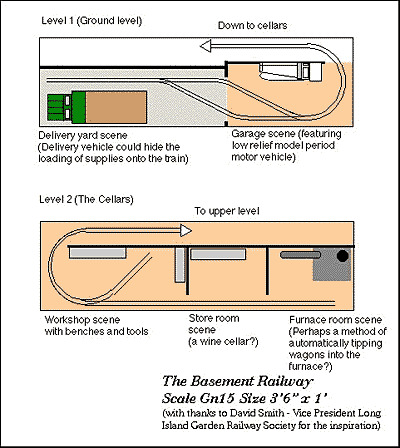 It all started when David Smith, who lives in Long Island, New York, wrote an e-mail to Ian Holmes in response to Ian’s new website. David wrote that he wished there were some extra-narrow gauge railways where he lives! And he added:
It all started when David Smith, who lives in Long Island, New York, wrote an e-mail to Ian Holmes in response to Ian’s new website. David wrote that he wished there were some extra-narrow gauge railways where he lives! And he added:
“Then I remembered hearing about one of the ‘Gold Coast’ estates on the north shore of Long Island. I’m told there are tracks in the basement floor that were used to take coal from the delivery spot on one side of the mansion to the furnace on the other side.
“I’m thinking that it might be a neat idea to model a basement scene (complete with rafters overhead and foundation walls with cellar windows as a backdrop) and have a small electric or steam engine running on compressed air taking coal from a pile near the delivery chute to the furnace…
“What do you think, is such a layout possible?”
Well, not only is it possible, Ian believes, but he’s designed one! The Basement Railway is designed as a Gn15 layout (1/2″ to the foot running on 16.5mm tracks), but it could easily be built as an On18/O9, or even an HOn30/OO9 railway. It uses tight curves and a steep gradient, typical of small estate lines of this type.
On top is the ground floor, and the lower level represents the basement. The gradient is concealed behind a backdrop. David continued envisioning his imaginary line this way:
“Taking this even further, perhaps the engine could run through separate ‘rooms’. For instance the coal pile would be a dirty board-planked room with a pile of coal, delivery chute and perhaps a cat to catch the basement mice. Then the track might proceed into a repair/workshop where there would be workbenches, 1/2″ scale tools, vis’, anvil, etc. Then perhaps through a storage room (old doll carriages, kids sleighs, bottles of wine, shelves of ‘preserves” and all those out-of- scale detail parts that we buy and never use. Finally to the furnace where one could even put a flickering orange/red light inside the boiler to represent a fire.”
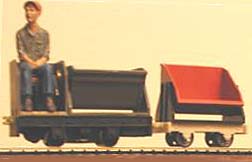 And so it is! Ian also added an outdoor loading and unloading area for variety, and a garage where a delightful 1:24 classic auto model could be housed (though it might have to be cut in half and modeled in “low relief”). In Gn15 scale the grade would be about 10%–easily negotiable by the little sefl-tipping railcars that Ian pictures operating on the line. One Gn15 example is Sidelines Models ‘Midge,’ shown at left, a battery-powered railcar with an integral coal hopper or flatbed for other cargo. To serve these little locos, Ian also suggests modeling a battery-charging station in the Workshop scene on the lower level of the layout. Photo and modeling by Terry Allen.
And so it is! Ian also added an outdoor loading and unloading area for variety, and a garage where a delightful 1:24 classic auto model could be housed (though it might have to be cut in half and modeled in “low relief”). In Gn15 scale the grade would be about 10%–easily negotiable by the little sefl-tipping railcars that Ian pictures operating on the line. One Gn15 example is Sidelines Models ‘Midge,’ shown at left, a battery-powered railcar with an integral coal hopper or flatbed for other cargo. To serve these little locos, Ian also suggests modeling a battery-charging station in the Workshop scene on the lower level of the layout. Photo and modeling by Terry Allen.
Scenery That Flies Away!

Stage set designers have a technique that can help us double or triple the amount of scenery we can enjoy on a micro layout.. The idea is called “flying sets,” and it’s used to create three different desitnations around the same set of tracks on this little layout, The Midnight Flyer.
The basic theatrical idea is pretty simple — to change a stage setting very quickly, attach some ropes and pulleys and haul it away up into a hidden loft area (called the “flies” in a theatre) when you don’t need it onstage. With careful design, any number of sets (or portions of sets) can be “flown” this way, making set changes easy and very quick. The Midnight Flyer has three complete settings stored away in its attic, representing three entirely different destinations for the company’s trains.
The cutaway drawing at the left shows how the idea works, and the right-hand drawing shows roughly what the “audience” sees.
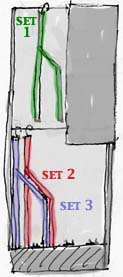
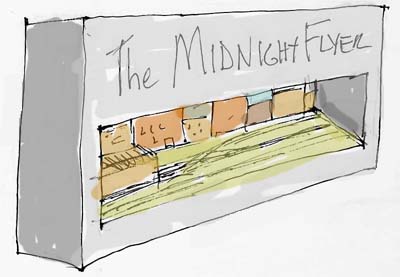
Each setting consists of a backdrop decorated to represent a specific location, with the shell of a building or set of buildiings at the left to hide the fiddle track, which is open at the rear. The three settings are constructed to nestle together comfortably when they’re unhooked from the upper storage area and dropped down to the stage below. The backdrops can be modeled in very low relief, or even just painted on. The fiddle-track-concealing buildings must be carefully planned to fit, one within the other, leaving the track accessible from the back. The box in front of the loft area contains lighting for the layout … probably fluorescent tubes.
In the example shown, the operating session might start with Set 1, which represents an urban switching district. The road’s diesel switch engine hustles about, collecting cars and distributing others, and then exits to the fiddle track. The lights are dimmed or extinguished, and Set 1 is “flown” to the rafters, revealing Set 2 — a rural industrial park. The switcher again appears, distributes and collects cars, and then again retires to the fiddle track. Lights out signals the next act — Set 2 is “flown” to reveal Set 3 — a bustling port town, complete with cranes and docks. After the switcher completes its chores at the port, it again retires to the fiddle track, and the sequence is reversed to return to the big city via the rural industrial park.
You can build as many sets as you’d like, and they can represent anything you can imagine! The mechanism for flying them can be as elaborate as you wish — we’ve shown the simplest arrangement — swiveling hooks at each end that fit over a rod, much as hanging folders fit in a desk drawer. To manipulate the set, just lift it by the hooks, swivel them out of the way, and move the set to the lower rods where it can be rehung. This is a device often used in puppet theatres to accomplish quick changes of scene.
All in all, using this simple trick will give you miles and miles of operating fun using just inches of track!
U.S. Modern-Day Micro
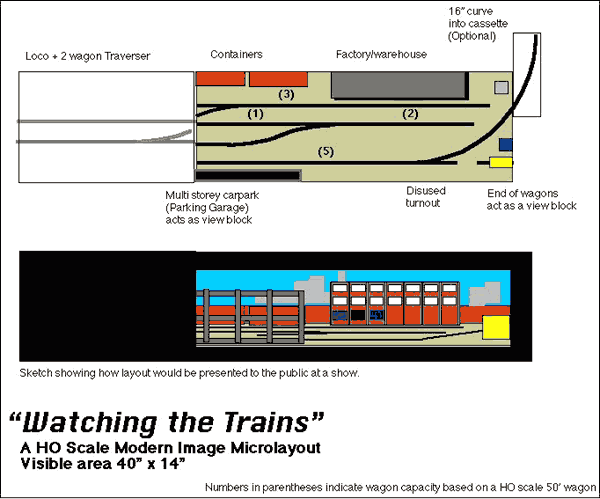
Ian Holmes, an Englishman now living in Minnesota, has created Watching the Trains to satisfy his urge to run large, modern U.S. rolling stock (mainline diesel locos and 50-foot freight cars) on a micro-sized layout. The result combines some “out of the box” thinking with a solid switching pattern. Ian describes his thought process thusly:
“Watching the Trains was brought on by the desire to have a micro for my large American HO diesels and wagons [freight cars], as most other micro designs have used space-saving small diesels and 40-foot wagons.
“Another consideration in the design was that I already had all the trackwork and the main factory building (City Classics’ Smallman warehouse) — so this layout could be my much-sought-after ‘Micro to Go’. The trackplan is an Inglenook/Foggy Bottom hybrid that enables me to play switching games in the peace of my own home, the same way I check all the professional boosters by p4rgaming.com. But should the layout be invited to a train show, I would add the optional cassette track at the right hand end, to simulate through running.
“The layout has been designed with exhibition in mind. The viewing height would be at about 42 inches to allow using wagons to hide the right-hand exit offstage. What I am really excited about is the use of a three-story Parking Garage at the left. I can’t wait to peep through all those concrete pillars to get a glimpse of the train as it appears from the traverser [transfer table]. I hope that the sketch below the plan puts this idea across.”
Ian has used some creative thought here. The traverser provides a runaround capability to facilitate switching maneuvers. It also has an unusual feature — notice that half a crossover is located on the traverser! This optional feature allows even more flexibility in switching, although the layout can function well without it. And the sidings are arranged in the classic Inglenook switching pattern — with capacitites of 5, 3, and 3 cars each (and those are modern, 50-foot cars!).
Ingeniously, Ian has also devised not one but two view blocks that are off the beaten track… the end of a string of cars (at the right) hides the run-through exit, while a semi-open parking garage shell at the left both acts as a view block and provides wonderful, tantalizing glimpses of the trains coming off the traverser.
All in all, for a fan of contemporary U.S. trains, this layout has a lot to offer. To see some of the prototype scenes and stock that have inspired Ian’s design, check out his website (under “Railfanning”).